Scanning electron microscopes (SEM) surpass traditional light microscopes in terms of resolution for small objects, depth of focus, and the ability to differentiate materials based on their composition. SEMs also facilitate elemental analysis through energy-dispersive X-ray spectroscopy (EDS).
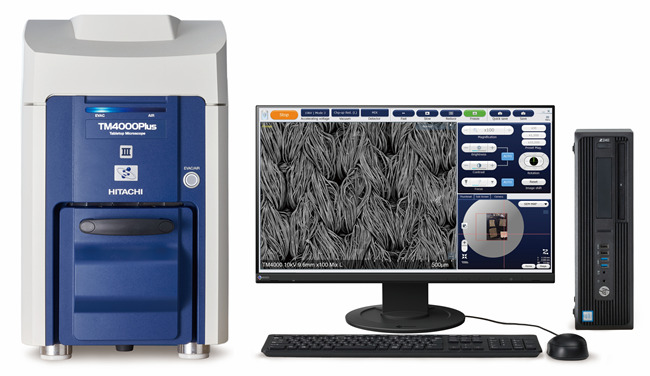
Image Credit: Hitachi High-Tech Europe
However, investing in a conventional SEM entails significant costs, complexity, and extensive training requirements, making integrating electron microscopy into research and development or quality control environments challenging.
Conversely, a compact, high-performance, and automated tabletop SEM presents a practical and cost-effective solution.
Tabletop microscopes provide high-resolution imaging and analysis without the need for substantial investment in larger, more expensive instruments that require significant space and operator training.
Hitachi’s TM4000PlusIII tabletop SEM is an excellent choice for academic and industrial laboratories seeking a versatile microscope without the associated high costs or large footprint.
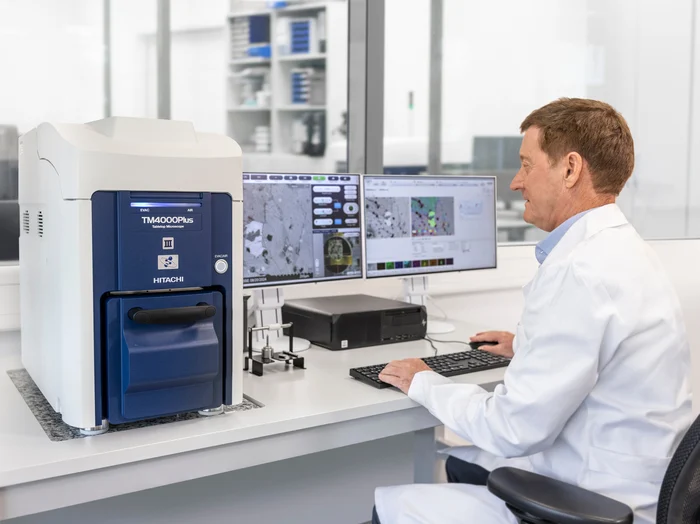
Image Credit: Hitachi High-Tech Europe
Why Choose the TM4000PlusIII?
Compact Powerhouse
The TM4000PlusIII offers reliable imaging and analytical capabilities within a compact footprint, making it easy to integrate into any workspace. Unlike traditional SEMs that demand extensive infrastructure and dedicated space, this tabletop SEM provides flexibility in placement and setup, making it an appealing option for labs aiming to optimize space without compromising imaging performance.
Accessible for Diverse Users
With its intuitive interface and automated functions, the TM4000PlusIII is user-friendly for individuals of all skill levels. Simple controls and smart automation features ensure that both experienced and novice operators can achieve consistent, high-quality results. The minimal learning curve makes the TM4000PlusIII ideal for educational institutions and high-turnover laboratories.
Versatile Applications
The TM4000PlusIII's adaptability makes it suitable for a diverse range of applications in materials science, biology, and industrial quality control. Its advanced imaging capabilities and optional elemental analysis enable laboratories to work with various sample types, providing structural and compositional data.
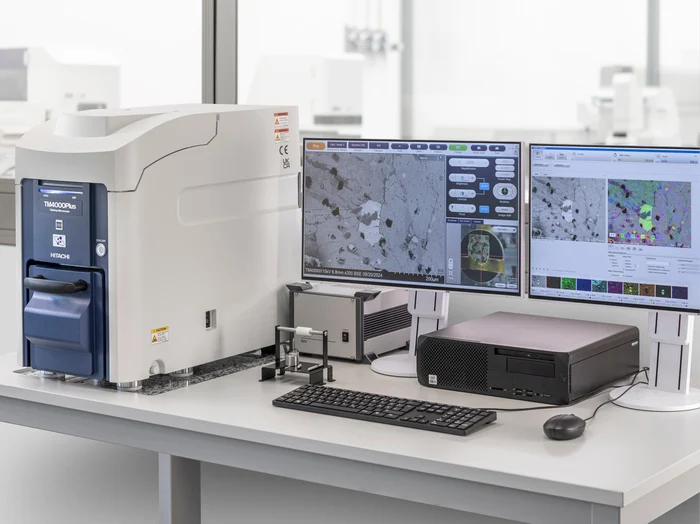
Image Credit: Hitachi High-Tech Europe
Key Features
Exceptional Resolution and Elemental Analysis
The TM4000PlusIII delivers precise, high-contrast imaging at accelerating voltages of 5, 10 or 15 kV, allowing users to tailor settings to specific sample requirements. A segmented high-sensitivity backscattered electron detector produces compositional, topographical or shaded images, while the secondary electron detector enhances fine surface details and cathodoluminescence information.
Optional EDS detectors benefit from an elevated 20 kV accelerating voltage and high probe current, providing enhanced functionality for conducting elemental analysis and compositional mapping efficiently.
Automation for Consistency and Efficiency
Automation is integral to the TM4000PlusIII, featuring automatic brightness and contrast adjustments for all detectors and high-accuracy auto focus. Workflow automation, including recipe control functions for automated stage movement, magnification adjustments, and image capture, minimizes the need for manual intervention. This reduces the burden of repetitive SEM tasks and ensures that less experienced operators can achieve reproducible results.
Enhanced Navigation with an Optical Camera
The TM4000PlusIII is equipped with a built-in color camera that captures overview images of samples, providing a zoomable, detailed map. This feature simplifies navigation across the specimen, allowing users to click on points of interest on the map. SEM overview images can be seamlessly integrated into the optical map, facilitating quick and accurate targeting of specific areas.
Flexible Imaging for Various Sample Types
The TM4000PlusIII features three low-vacuum modes, a high-sensitivity backscattered electron (BSE) detector, and a low-vacuum-capable secondary electron (SE) detector, enabling it to accommodate a diverse array of samples, including both conductive and non-conductive specimens.
This system allows for handling various sample types with minimal pre-preparation - a significant advantage for laboratories that work with a wide range of materials. By reducing the necessity for extensive sample preparation, you can concentrate on analysis, saving time without compromising imaging quality.
Intuitive Interface for All Users
The TM4000PlusIII’s interface is designed with a focus on simplicity and functionality. It offers a seamless experience for both novice users and experienced operators. User-friendly controls and reliable automatic image adjustment functions facilitate a quick start, while advanced settings are available for those who wish to customize workflows.
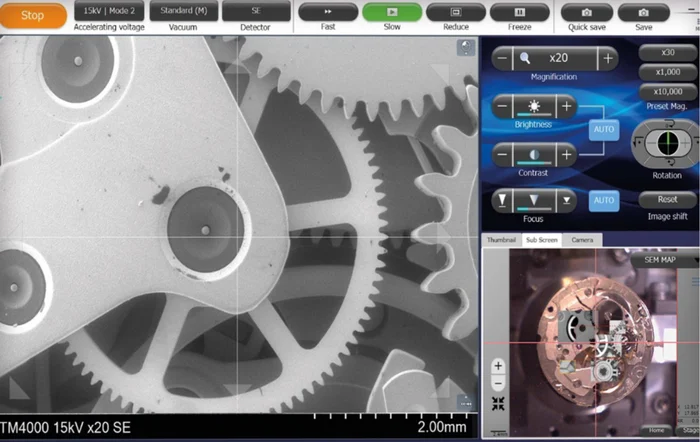
Image Credit: Hitachi High-Tech Europe
Advanced Analysis and Optional Accessories
Integrated EDS for Elemental Mapping
As mentioned, the TM4000PlusIII provides integrated EDS options for laboratories requiring compositional data alongside imaging. Key features include high probe currents, a maximum accelerating voltage of 20 kV, and instant switching between imaging and EDS analysis without needing to relocate the specimen.
This capability enables accurate elemental analysis with speed and ease, facilitating deeper insights into material composition and structure.
Optional Features
In addition to workflow automation functions such as Multi-Zigzag, Python scripting, and the graphically oriented EM Flow Creator, the functionality of the TM4000PlusIII can be enhanced with the following options:
- STEM holder for transmission imaging on thin samples
- 3D sample surface reconstruction feature
- Tilt-and-rotation specimen stage
- Peltier-type specimen cooling stage, enabling imaging of hydrated samples in their natural state

Image Credit: Hitachi High-Tech Europe
Cost Efficiency and Maintenance Advantages
Low Maintenance Requirements
The TM4000PlusIII is engineered for ease of maintenance, featuring a filament monitoring system that tracks filament usage, optimizes lifespan, and projects remaining operational life. This proactive approach assists laboratories in planning maintenance schedules in advance, minimizing downtime, and ensuring the microscope remains ready for high-demand applications.
Cost-Effective Solution for Advanced Microscopy
The TM4000PlusIII delivers advanced imaging and analysis capabilities at a lower operational cost than full-sized SEMs. This tabletop SEM represents an economical choice for laboratories seeking high-quality performance without the associated high overhead.
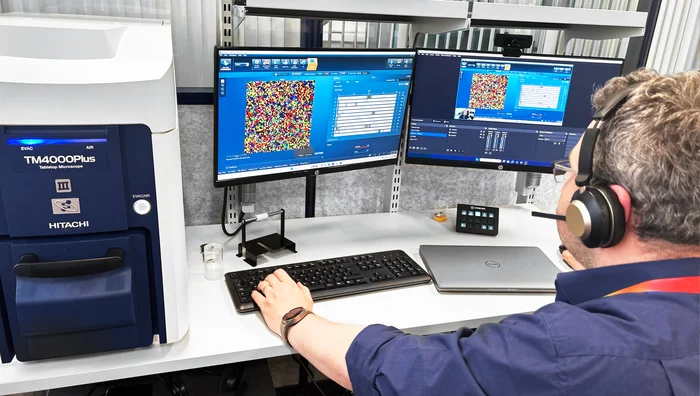
Image Credit: Hitachi High-Tech Europe
Conclusions
The Hitachi TM4000PlusIII integrates powerful scanning electron microscopy capabilities into a compact and accessible design. It serves as a valuable asset for any laboratory seeking reliable imaging and analysis.
With its extensive features, intuitive operation, and minimal maintenance requirements, the TM4000PlusIII supports laboratory managers, research scientists, and quality control teams in achieving their microscopy objectives.

This information has been sourced, reviewed and adapted from materials provided by Hitachi High-Tech Europe.
For more information on this source, please visit Hitachi High-Tech Europe.